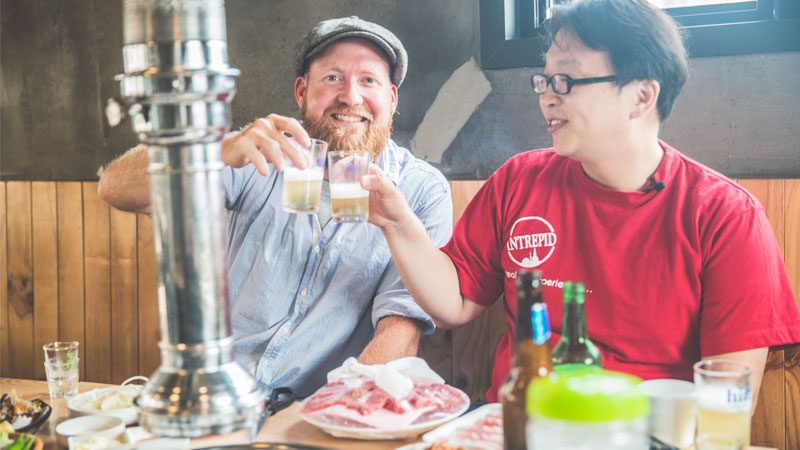Experiencing different foods is one of the best parts of traveling – we can all agree on that. But, with new food comes new customs. At one dinner table it might be perfectly acceptable to refuse seconds, but at a table across the world you might be offending the host and your dining companions. Never let the fear of appearing rude stop you from taking the culinary plunge. Instead, get brushing up on your dining etiquette and tipping know-how.
If you’re traveling to Asia, you’re in luck – we’ve created a guide to dining in eight different Asian countries. By the time you arrive, you’ll know everything you need to be an impeccable dinner guest. You’re welcome.
Cambodia
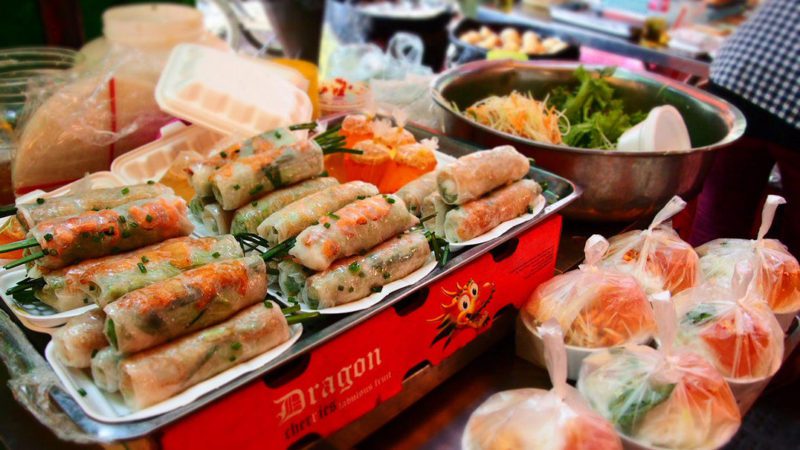
Cambodia’s cuisine is as spectacular as its landscapes, and that’s saying something. It’s also very unique from what you’ll get food-wise in Thailand and Laos, hence our 10-day Real Food Cambodia tour that’ll take you on quite the culinary adventure. While you’re enjoying the wide variety of dishes you’ll encounter, don’t hesitate to verbally express your enjoyment. No one will look at you disapprovingly if you want to indulge in a slurp or two. But, that doesn’t mean rules go out the window. If you’re dining with a large group, remember that seniority matters. Generally, the oldest person will be seated first and will be the first to begin eating.
When you look down at the table, you might notice a few different things. Place settings will have plenty of forks, spoons and chopsticks, but (usually) no knives. Avoid placing a fork directly in your mouth. Instead, use the fork to guide food onto your spoon or between your chopsticks. You can also expect to see more than you ordered arrive at the table. Try a little bit of everything, or nothing at all. You’ll only be charged for the extras you do decide to taste. When it comes time to pay the bill, don’t fret about tipping. It is welcome in any amount, but not expected.
India
Indian cuisine and customs vary widely throughout the country, as you might expect from such a vast place. In some places it may be common practice to eat with your hands, while in others you may eat with a spoon and a fork. In either case, diners will thoroughly wash their hands before each meal. If you are in an area that favors hands over cutlery, you should generally eat only with your right hand. Your other hand will remain clean to pass dishes and help serve your neighboring diners. Vegetarians and meat eaters eat side by side with no problem, but it is important to remember not to mix up your utensils. Something used to serve a meat dish should not wander onto a vegetarian plate.
Double dipping or serving food with your fingers or utensils that have been in your mouth is considered very rude. Tipping in India is customary. On smaller bills, you can tip 7 percent to 10 percent, while 5 percent to 7 percent is an acceptable amount on larger bills. In some cases you might see a service charge on your bill, which means no additional tip is necessary. It is considered polite for your host to offer you food many times. Come to the table hungry!
RELATED: CHECK OUT OUR 15-DAY FOOD GROUP TOUR IN INDIA
Vietnam
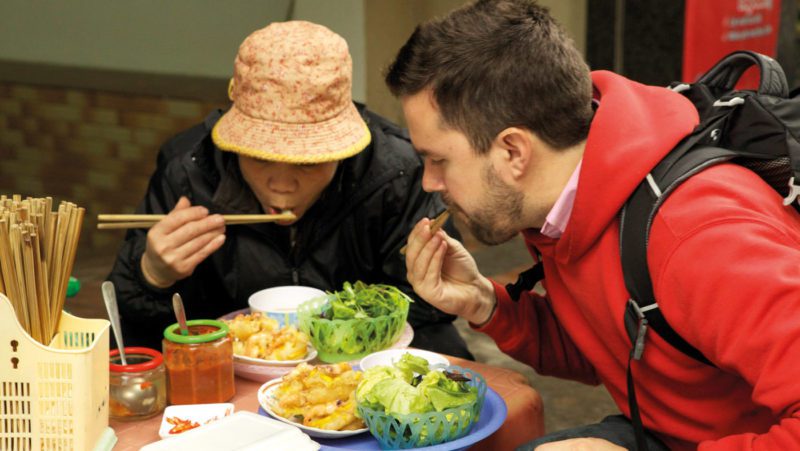
Vietnamese meals are served family-style, shared communally, and are so good you’ll want to experience our 12-day Food Tour there forever. Be ready to try lots of different dishes while enjoying lively conversation. You’ll likely be eating with chopsticks and a spoon. If you aren’t confident in your chopstick skills, you can ask for a fork at restaurants. It might be considered rude to put both hands on the table in Western society, but it is expected at a Vietnamese dining table. With both hands on the table, you can hold your rice bowl and chopsticks at the same time. It is commonplace to bring the bowl close to your face while eating.
While dining out, it is customary for men to be served first. When it comes to paying, get up and ask for your check. The Vietnamese consider it rude for servers to bring the bill to the table. Finally, we address the age old question of tipping. Tipping is not a common custom in Vietnam, so don’t feel any pressure to leave something extra. If you are invited to dine at a local’s home instead of out at a restaurant, bring a gift with you to show respect and gratitude.
China
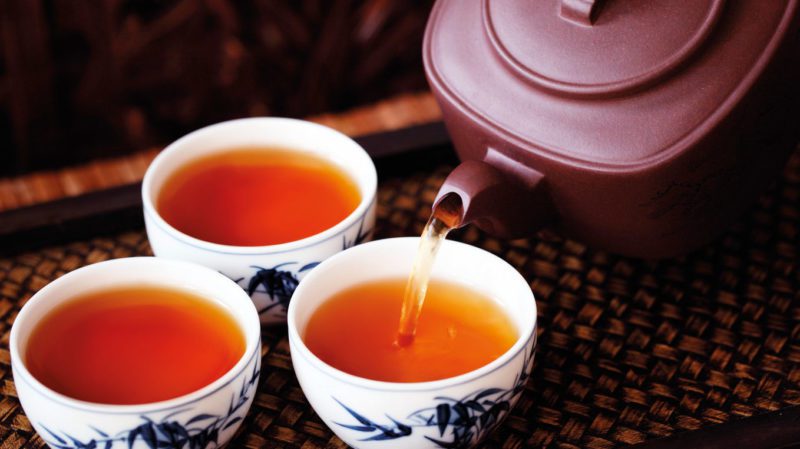
China is an exceptionally large, diverse country with bustling cities, remote rural areas and everything in between. This means you’re bound to encounter regional differences in etiquette, but we’ve put together some basic rules to follow once you are ready to sit down and dine. Seniority rules again when it comes to seating and deciding when to dig into the dishes on the table. Once you’ve begun to eat, remember to avoid resting your chopsticks vertically. This faux pas – something many other Asian countries observe – may seem harmless enough, but it is considered a harbinger of death. When in doubt, just use the chopstick stand that is likely on your table.
When it comes to eating, mind your manners much like you would at home. Don’t chew with your mouth open. Help yourself from dishes in front of you and wait for other dishes to come to you. Tea will be a staple of most meals in China. Servers will bring a pot almost as soon as you sit down. After that, you and your dining companions will pour for themselves. When one of your companions does you the courtesy of pouring you a cup, you can tap two fingers on the table a few times, signifying your gratitude. Tipping is not a regular practice, but you are welcome to leave one if you are pleased with the service at a more formal eatery.
Japan
Polite eating in Japan has much to do with your ability to handle chopsticks. Your access to other eating utensils will be pretty limited. Remember not to wave your chopsticks or skewer your food. You may sit on a tatami, a traditional Japanese mat, at a low-set table. The proper way to sit is with your heels tucked beneath you. Before eating, you can wipe your hands with a warm towel (use this towel only on your hands). When it comes to eating, look to your host as a guide. You can begin eating when he or she does. You can take clues from the others dining with you as well.
Remember to use soy sauce judiciously. Pour a small amount in the separate dish provided and dip your food. If you want to follow etiquette as closely as possible, always do your best to eat everything on your plate. For after dinner drinks, serve your dining companions and they will do the same for you. It is likely your host will pay for the meal, but if you are the highest ranking person at the table settling the bill will fall to you. Place the money for the meal on the small tray put on the table, rather than handing money directly to the server. Tipping is not necessary and can be considered outright rude.
RELATED: CHECK OUT OUR 12-DAY FOOD GROUP TOUR IN JAPAN
South Korea
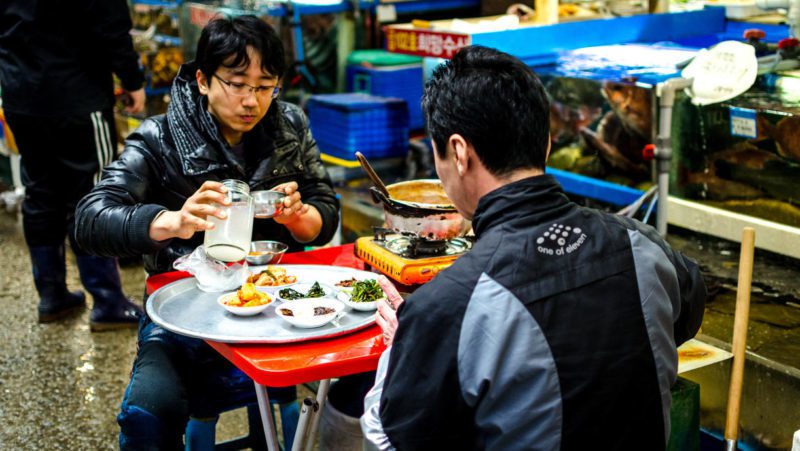
If you are dining in someone’s home in South Korea, you should remove your shoes. In a restaurant, it is possible you will be sharing a table with another dining party. Feel free to chat with your group as if you had your own table. Avoid gobbling up your food or lingering over your dishes. Pace yourself with your companions – particularly the eldest person at the table, who will be the first person to begin eating. Stick to proper chopstick etiquette. Avoid resting your chopsticks vertically, just as you would in China and many other Asian countries.
In South Korea, it is polite to tell your host how much you are looking forward to the meal and to thank him or her afterwards (aside: you can’t not enjoy a meal on our 8-day foodie tour of the country). Come prepared to drink at the meal. It is rude to decline an offer for alcohol. Cangai! Expect to hear this common toasting word, which means “bottoms up.” You and your neighbors will be expected to refill one another’s drinks through the meal. Whoever invited the group to dine will generally pay for the meal. If you find yourself in charge of the bill, you do have the option to tip. This is by no means expected, but you can leave a 5 percent tip if you are pleased with the service in a restaurant.
Myanmar
Traditional dishes in Myanmar, formerly Burma, include staples like rice, noodles and palata – a type of flatbread. Meals in Myanmar are typically served at a low, round table. You can expect to see eating utensils at restaurants, but this is less likely if you are dining in someone’s home. If you are sitting down to a meal without utensils, you should eat with your right hand. Use all of your fingers and try to be as neat as possible. As with many of the other countries we’ve touched on, elders will dine first. You might be accustomed to meals being served in separate courses, but in Myanmar a wide variety of dishes will arrive at the table all at once. Your host or hostess will offer you servings throughout the entire meal.
It is also important to note that food, rather than polite conversation, is the focus of mealtimes. Yes, you can dig in and eat your fill without worrying about making conversation between mouthfuls! If you feel the need to sneeze, cough or blow your nose, excuse yourself from the table. When you are done eating, feel free to stand up and wash your hands in a nearby basin. You can tip in Myanmar at your discretion. It is not expected, but it can be appreciated. Though don’t be surprised in some cases if your server tries to hand the tip back to you – it all depends on where you are eating.
RELATED: CHECK OUT OUR 12-DAY MYANMAR GROUP TOUR
Thailand
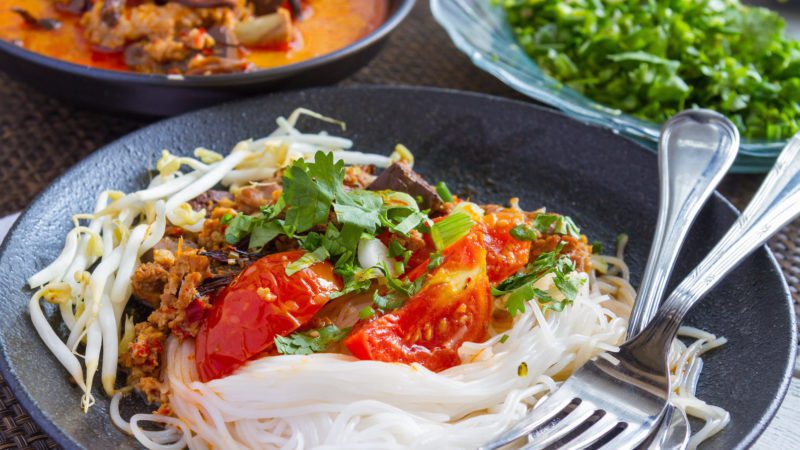
When dining in Thailand, be ready to share your food (though that might be tough!). Everything ordered at a restaurant is meant to be shared amongst the whole group. You can feel free to speak up during the ordering process and ask your host to order a few things you would like to try, but keep in mind those dishes will go around the whole table. Before you sit down and get ready to order, look to your host. He or she will likely tell you where to sit. Once the delicious dishes arrive, keep in mind a few basic rules. Avoid taking more food than you can eat. It is impolite to leave large amounts of uneaten food on your plate.
Eat a leisurely pace. As you take your time savoring all of the different dishes, keep in mind that it’s rude to eat noisily. Some utensil rules common in Asian countries are going to pop up. Don’t eat with your fork, but do use it to push food onto your spoon. If you find yourself the guest of honor, be ready to give a short toast at the end of the meal. Your host or hostess will likely give a short toast before you. At the end of the meal, it is polite to offer to pay, even if only for your part of the meal. Make the offer once, and if it is declined you can gracefully agree. The more upscale the restaurant, the more common it is to tip (the amount is up to you).
Images c/o Intrepid Travel.
Ready yet to book a life-changing trip to Asia? Check out our Asia tours.

